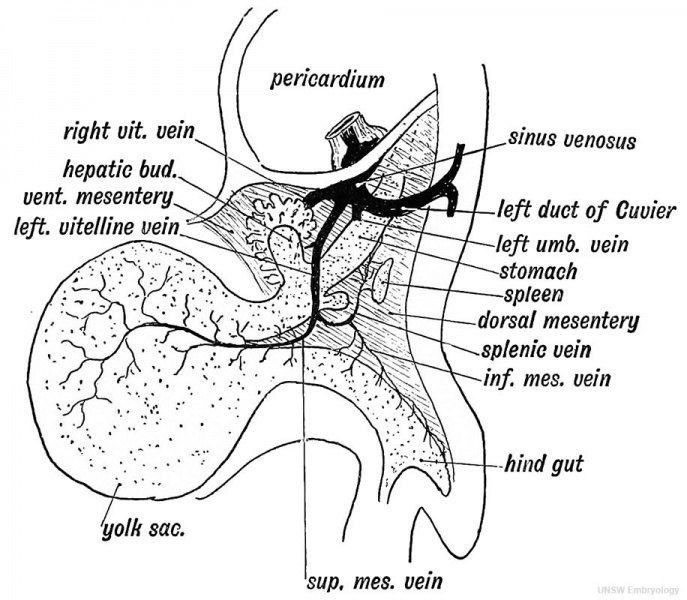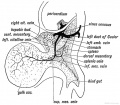File:Keith1902 fig187.jpg

Original file (916 × 800 pixels, file size: 138 KB, MIME type: image/jpeg)
Fig. 187. The Left Vitelline Vein of an Embryo of the 4th week
The Portal Vein is formed out of the two vitelline veins — the first of all the veins to be developed. They end in the posterior chamber of the tubular heart of the embryo — the sinus venosus. The vitelline veins, right and left, arise from ramifications on the yolk sac and pass in the splanchnopleure to the sinus venosus (Fig. 187). The nutriment within the yolk sac is thus carried to the heart and distributed by the heart to the tissues of the embryo and yolk sac. The commencement of the left vitelline or omphalo-meseraic vein disappears. The right (Fig. 187) forms the superior mesenteric vein. It commences on the yolk sac, of which a remnant (the neck) may remain as Meckel's diverticulum.
The terminal parts of the two vitelline veins are joined by three transverse communications, the upper two of which are included in the portal vein. The uppermost of the three afterwards lies in the transverse fissure of the liver (Fig. 188). The middle communication lies on the dorsal aspect of the duodenum (Fig. 188). The splenic vein and inferior mesenteric pass in the dorsal mesentery (Fig. 187) and join this transverse communication which may be named the supra-duodenal junction. The third or lowest of the junctional trunks is situated on the ventral aspect of the duodenum (Fig. 188). Two parts may be recognised in the portal vein of the adult : (1) the part which lies behind the pancreas and duodenum ; (2) the part in the gastro-hepatic omentum and transverse fissure of the liver.
- Circulatory System: Fig. 181. Adult Superior Vena Cava | Fig. 182. Embryonic Venous Trunks forming Superior Vena Cava | Fig. 183. Ducts of Cuvier | Fig. 184. Left Superior Vena Cava Remnants | Fig. 185. Sinus Venosus and Ducts of Cuvier 3rd week | Fig. 186. Posterior Cardinal Veins Remnants | Fig. 187. Left Vitelline Vein 4th week | Fig. 188. Diagram showing the Formation of the Ductus Venosus, and the fate of the Umbilical and Vitelline veins. The arrows show the parts of the Vitelline Veins which become the Portal Vein. | Fig. 189. Umbilical Vein Remnants | Fig.190. Right Umbilical Vein 3 weeks | Fig.191. Right and Left Cardiac Tubes | Fig.192. Fusion of Right and Left Cardiac Tubes | Fig.193. Dorsal and Ventral Mesocardia | Fig.194. Primitive Heart Divisions | Fig.195. Heart Bends 3rd week | Fig.196. Sinus Venosus | Fig.197. Heart 5th week | Fig.198. Heart Septa | Fig.199. Fetal Heart Ventricles | Fig 200. Semilunar valves | Fig 201. Embryo Coelom 3rd week | Fig. 202 Heart Arterial and Venous Mesocardia week 3 | Figures
| Historic Disclaimer - information about historic embryology pages |
|---|
| Pages where the terms "Historic" (textbooks, papers, people, recommendations) appear on this site, and sections within pages where this disclaimer appears, indicate that the content and scientific understanding are specific to the time of publication. This means that while some scientific descriptions are still accurate, the terminology and interpretation of the developmental mechanisms reflect the understanding at the time of original publication and those of the preceding periods, these terms, interpretations and recommendations may not reflect our current scientific understanding. (More? Embryology History | Historic Embryology Papers) |
Human Embryology and Morphology (1902): Development or the Face | The Nasal Cavities and Olfactory Structures | Development of the Pharynx and Neck | Development of the Organ of Hearing | Development and Morphology of the Teeth | The Skin and its Appendages | The Development of the Ovum of the Foetus from the Ovum of the Mother | The Manner in which a Connection is Established between the Foetus and Uterus | The Uro-genital System | Formation of the Pubo-femoral Region, Pelvic Floor and Fascia | The Spinal Column and Back | The Segmentation of the Body | The Cranium | Development of the Structures concerned in the Sense of Sight | The Brain and Spinal Cord | Development of the Circulatory System | The Respiratory System | The Organs of Digestion | The Body Wall, Ribs, and Sternum | The Limbs | Figures | Embryology History
Reference
Keith A. Human Embryology and Morphology. (1902) London: Edward Arnold.
Cite this page: Hill, M.A. (2024, April 27) Embryology Keith1902 fig187.jpg. Retrieved from https://embryology.med.unsw.edu.au/embryology/index.php/File:Keith1902_fig187.jpg
- © Dr Mark Hill 2024, UNSW Embryology ISBN: 978 0 7334 2609 4 - UNSW CRICOS Provider Code No. 00098G
File history
Click on a date/time to view the file as it appeared at that time.
| Date/Time | Thumbnail | Dimensions | User | Comment | |
|---|---|---|---|---|---|
| current | 09:13, 20 January 2014 |  | 916 × 800 (138 KB) | Z8600021 (talk | contribs) |
You cannot overwrite this file.
File usage
The following 4 pages use this file:
